
* From World War II, the Swedish SAAB firm built a series of advanced fighter aircraft, which all traced their ancestry back to the first SAAB fighter, the twin-boom pusher-propeller "J 21" designed during the conflict and the jet-powered "J 21R" designed from it. Although the J 21 series did not see significant service, it demonstrated considerable design ingenuity and laid the industrial foundations for more advanced machines. This document provides a history and description of the J 21 series -- as well as the interim "J 22" designed roughly in parallel, and other twin-boom pusher fighters developed during and after the war.
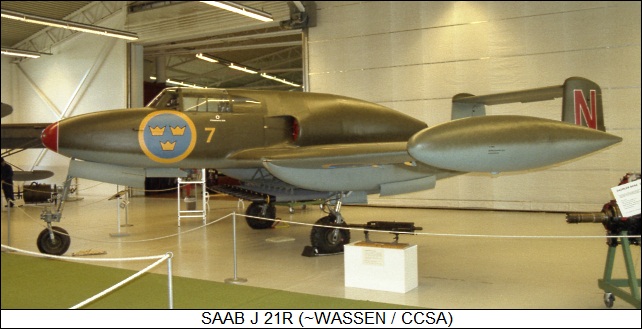
* The outbreak of World War II in September 1939 left Swedes feeling very vulnerable. Although Sweden had a long tradition of neutrality, the aggressive Nazi regime in Germany to the south didn't seem inclined to respect the sanctity of national borders. That was emphasized in April 1940, when Germany invaded and conquered Denmark and Norway.
At the beginning of the war, the Flygvapnet -- Swedish air force -- had all of a hundred combat aircraft, and they were completely obsolete. The Swedes desperately tried to obtain combat aircraft from elsewhere, but with a big war on the market was tight, and such machines as the Flygvapnet was able to obtain from the US and Italy were still unsatisfactory. The only thing the Swedes could do was build their own fighters. Two projects were initiated: one was for a full-scale fighter, the "J 21", to be built by Svenska Aeroplan Aktiebolaget (SAAB), while the other was for a lightweight fighter, the "J 22", to be built on a fast track under the direct supervision of the Flygvapnet, with a temporary organization, the "FlygFoervaltningens Verkstad i Stockholm (FFVS)", set up to handle the project.
The J 22 project team was led by Bo Lundberg, with the design specifications providing the basic constraints that it would use the "STWC-3" engine, a Pratt & Whitney Twin Wasp air-cooled radial built under license in Sweden, and be of simple construction using nonstrategic materials. The initial flight of the first J 22 prototype was on 20 September 1942; it was followed by a second prototype. Both were lost in accidents, but trials were regarded as successful enough to lead to production. 198 J 22s were delivered to the Flygvapnet from 1943 to 1946.
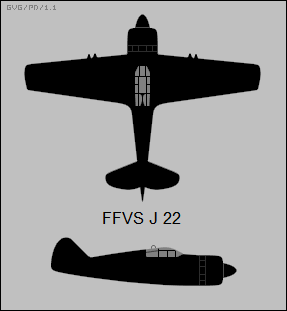
The machine was a fairly typical early-war day fighter, with some resemblance to a scaled-down German Focke-Wulf Fw 190. It was a low-wing aircraft with a conventional tail assembly, an STWC-3 engine providing 795 kW (1,065 HP), a "razorback" style canopy, and taildragger landing gear -- the tailwheel being fixed, and the main gear hinging in the wings to retract towards the fuselage. The main gear could be fitted with skis, but that was never done operationally. It had a steel tube frame with plywood skinning. Performance was said to be very good, at least for an aircraft of its size and power class.
___________________________________________________________________
FFVS J 22:
___________________________________________________________________
wingspan:
10 meters (32 feet 10 inches)
wing area:
16 sq_meters (172.2 sq_feet)
length:
7.8 meters (25 feet 7 inches)
height:
2.8 meters (9 feet 2 inches)
empty weight:
2,020 kilograms (4,453 pounds)
normal loaded weight:
2,835 kilograms (6,250 pounds)
max speed at altitude:
575 KPH (360 MPH / 310 KT)
service ceiling:
9,300 meters (30,500 feet)
range:
1,270 kilometers (790 MI / 685 NMI)
___________________________________________________________________
Armament consisted of four machine guns in the wings -- in the initial "J 22A" version, consisting of two 13.2-millimeter and two 7.9-millimeter machine guns; in the final "J 22B" version, consisting of four 13.2-millimeter machine guns. A total of 143 J 22As and then 55 J 22Bs was delivered. In 1946, nine J 22As were rebuilt into reconnaissance machines and redesignated "S 22", where "S" stood for "spaning (reconnaissance)", though they were later reconverted back into fighters. All were finally retired in 1952. At least one survives as a museum exhibit.
BACK_TO_TOP* Development of the heavier SAAB J 21 took considerably longer than development of the lightweight J 22. After proposing a number of designs for a high-performance single-seat fighter, a SAAB company team under Frid Waenstrom finally came up with an unconventional proposal for a twin-boom fighter with a pusher propeller. The concept was not entirely new, having been nothing particularly unusual in the First World War -- British Vickers fighters often featured such an arrangement -- but in more recent times, it had been generally abandoned.
In late 1941 the Flygvapnet gave the go-ahead for the J 21 proposal; since the Swedes didn't have an engine that provided adequate power, efforts were begun to set up an agreement with the Germans to obtain Daimler-Benz DB 605B liquid-cooled vee-12 engines, providing 1,100 kW (1,475 HP). Obtaining the DB 605B engines proved a bit tricky, since the Germans dragged their feet on delivery, and when samples were delivered in June 1942 they were defective -- apparently having been sabotaged by slave laborers working on the assembly line. The Swedes did manage to get engineering data to begin construction of the engines by Svenska Flygmotor (later Volvo Aero) under license, and finally obtained working samples from the Germans.
The engine problem addressed, the initial flight of the first J 21 prototype was performed on 13 July 1943, with SAAB chief test pilot Claes Smith at the controls. It was an exciting flight, with the machine barely getting off the end of the runway -- thanks to ill-advised recommendations by the engineers to Smith that he take off with full flaps -- and losing its brakes on landing, with Smith managing to stop using an anti-spin parachute that had been fitted to the machine, though then the landing gear collapsed. Smith was reprimanded for taking off with full flaps.
Two flight prototypes and a ground-test airframe were built. Getting the machine in production proved troublesome, and the first J 21s didn't enter operational service until December 1945, months after the end of the war. The aircraft featured a laminar flow wing and tricycle landing gear, all with single wheels, the nose gear retracting back into the nose and the main gear retracting back into the booms. An ejection seat was developed to allow the pilot to get out without hitting the rear prop. Armament was two 13.2-millimeter machine guns and a single 20-millimeter cannon in the nose, plus a 13.2-millimeter gun at the end of each boom, providing a respectable armament of five large-caliber guns.
Performance was generally good by piston fighter standards, with the aircraft featuring heavy and concentrated firepower, excellent handling, benign stall characteristics, and a very tight turning circle. The Flygvapnet had obtained a number of North American P-51D Mustangs, giving them the designation of "J 25", and J 21 pilots felt they were more than a match for the Mustang -- at least at low altitudes, the J 21's performance falling off at higher altitudes. Other limitations were poor rearward visibility and heavy controls, making air combat tiring.
___________________________________________________________________
SAAB J 21:
___________________________________________________________________
wingspan:
11.61 meters (38 feet 1 inch)
wing area:
22.2 sq_meters (239 sq_feet)
length:
10.44 meters (34 feet 3 inches)
height:
4 meters (13 feet 2 inches)
empty weight:
3,250 kilograms (7,165 pounds)
MTO weight:
4,415 kilograms (9,730 pounds)
max speed at altitude:
640 KPH (400 MPH / 350 KT)
service ceiling:
10,200 meters (33,450 feet)
range:
1,500 kilometers (930 MI / 810 NMI)
___________________________________________________________________
A total of 297 production machines was built to 1948, including 178 "J 21A" fighters and 119 "A 21A" attack variants. The A 21A featured a SAAB BT9 bombsight and six stores pylons -- one inboard of the boom on each wing, capable of handling a bomb of up to 600 kilograms (1,325 pounds) weight, and two outboard of the boom on each wing, each capable of handling a bomb of up to 50 kilograms (110 pounds) weight. Unguided rockets could be carried instead of bombs, and an external fuel tank with a capacity of 400 liters (106 US gallons) could be fitted to each wingtip.
In the immediate postwar period, the age of the piston fighter was clearly drawing to a close and the J 21's flight career was not particularly noteworthy. One of the few distinctions achieved by the type was that it was the first Swedish aircraft to perform an ejection -- with Lieutenant Bengt Johanssen punching out on 29 July 1946, after a collision between a J 21 and a J 22. The J 22 pilot had to bail out as well, with both men surviving. The last J 21s and A 21s were withdrawn from service in the early 1950s. Only two survive.
BACK_TO_TOP* There was talk of a "J 21B" version in the postwar period, with a Rolls-Royce Griffon inline engine, a pressurized cockpit, and a bubble canopy, but of course interest in that timeframe had moved on to jet propulsion. In 1945, plans were laid to adapt the J 21 to jet power using the de Havilland Goblin centrifugal-flow turbojet, bought from the UK in anticipation of license construction as the "RM 1" in Sweden. There were hopes that the jet engine could be fitted with minimal redesign, but as it turned out about half of the aircraft had to be rebuilt -- in particular, to raise the tailplane above the jet exhaust, and to reprofile the wings.
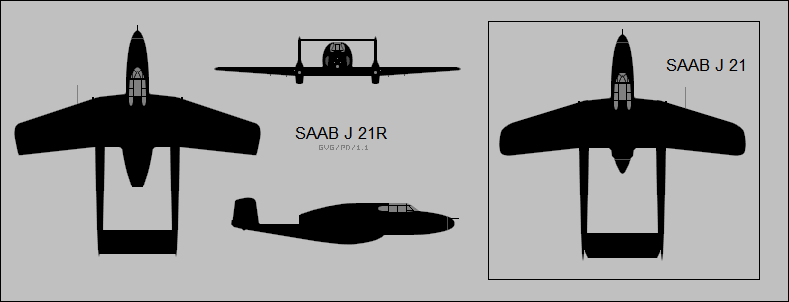
The first of four flight prototypes of the "J 21R" -- the "R" stood for "reaction jet" -- performed its initial flight on 10 March 1947, with Aeke Sunden at the controls. All the prototypes were conversions of J 21s. Initial production deliveries were in the summer of 1949, with a total of 64 J 21Rs delivered. The first 34 featured the RM 1 / Goblin 1 engine with 13.1 kN (1,335 kgp / 2,945 lbf) thrust and were designated "J 21RA", while the final 30 were fitted with the RM 1A / Goblin 3 with 14.7 kN (1,500 kgp / 3,305 lbf) thrust and were designated "J 21RB".
___________________________________________________________________
SAAB J 21R:
___________________________________________________________________
wingspan:
11.37 meters (37 feet 4 inches)
wing area:
22.3 sq_meters (240 sq_feet)
length:
10.56 meters (34 feet 8 inches)
height:
4 meters (13 feet 2 inches)
empty weight:
3,112 kilograms (6,861 pounds)
MTO weight:
5,615 kilograms (12,380 pounds)
max speed at altitude:
800 KPH (500 MPH / 435 KT)
service ceiling:
12,000 meters (39,360 feet)
range:
900 kilometers (560 MI / 485 NMI)
___________________________________________________________________
Fighter design was moving at a rapid pace at the time and the J 21 was obsolete from the start, being quickly relegated to the attack role as the "A 21R", carrying up to ten 15-centimeter (5.9-inch) or 18-centimeter (7.1-inch) unguided rockets. It could also carry a centerline gun pod with eight 8-millimeter machine guns for strafing, with pilots finding the experience of firing all 13 guns at once to be "exciting". Handling was as good as that of the J 21, but performance was uncompetitive with other jet fighters of the era, and fell off badly at altitude. Endurance was poor, though the wingtip tanks of the A 21 could be fitted to improve matters.
However, even as the J 21R was being put into service, SAAB was working on a much more advanced jet fighter, the "J 29 Tunnan", that would be a match for foreign jet fighters of its era. The J 21R, like many very early combat jets elsewhere, was mostly a learning experience for Swedish industry and the Flygvapnet. All J 21Rs were retired by the mid-1950s. Only one survives today, as a museum display.
BACK_TO_TOP* While the J 21's configuration was unusual for its era, other fighters with such a configuration were built elsewhere during and just after World War II, though only the J 21 reached production. In the late 1930s, the Fokker company of the Netherlands came up with a design for a twin-engine fighter with twin booms, a low wing, retractable tricycle landing gear, and a "push-pull" engine arrangement -- one engine in the nose, one in the rear. The single prototype of the "D XXIII" performed its initial flight on 30 May 1939. The production machine was to be of all-metal construction, with armament of two 7.9-millimeter (in the nose) and two 13.2-millimeter FN-Browning machine guns (one in each boom), but the prototype had wooden wings and was unarmed.
The D XXIII was powered by twin 394 kW (528 HP) Walter Sagitta I-SR air-cooled 12-cylinder vee inline engines, driving three-bladed propellers. The production machine was to have a length of 10.2 meters (33 feet 6 inches), a span of 11.5 meters (37 feet 9 inches), an empty weight of 2,180 kilograms (4,806 pounds), and a top speed of 525 KPH (326 MPH). Different engine configurations were considered, but by the time of the fall of the Netherlands to the Germans in the spring of 1940 technical difficulties, particularly with engine cooling, had limited the total flight time to four hours, and the Nazi occupation put an abrupt stop to the development effort.
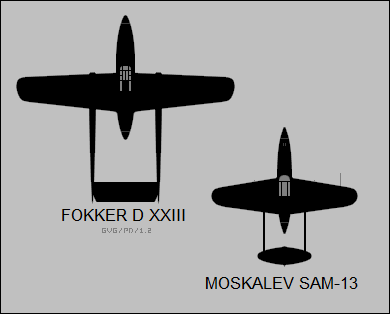
* The Soviets had experimented with the twin-boom push-pull fighter in the early 1930s in the form of the Tupolev ANT-23, an interesting design that featured an open cockpit and fixed landing gear, as was normal at the time, but fore-and-aft Gnome-Rhone radial engines, plus a 76-millimeter recoilless cannon in each boom. The idea seemed interesting; however, the program proved "snakebitten", and was abandoned in 1933.
The Fokker D XXIII apparently inspired the Soviets to come back to the concept. The "Moskalev SAM-13" featured much the same configuration as the D XXIII, making it one of the first Soviet aircraft with retractable tricycle landing gear -- though uniquely it only had a single tailfin, right in the middle of the tailplane. The SAM-13 was, however, much smaller than the Fokker D XXIII, a true "lightweight fighter", with a length of 7.68 meters (25 feet 3 inches), a span of 7.30 meters (23 feet 11 inches), and an empty weight of only 754 kilograms (1,662 pounds).
The SAM-13 was powered by twin Renault MV-6 air-cooled 6-cylinder inverted inline engines in a push-pull arrangement driving two-bladed propellers, with each engine providing 176 kW (236 HP). Armament was to be four 7.62-millimeter ShKAS machine guns, with two in the nose and one in each boom. Two test flights were performed in late 1940; top speed was expected to be a respectable 680 KPH (422 MPH), but though speed trials were to be performed on the second test flight, the nose landing gear refused to retract. Even given that problem, the SAM-13 was still clocked at 560 KPH (348 MPH), suggesting that the performance spec was not unrealistic.
The two test flights revealed various deficiencies and the design team went back to the drawing board to fix them, but the program was abandoned in the summer of 1941, when the Nazis attacked the Soviet Union. In hindsight, it would have been interesting to see what could have been made of the SAM-13; it was clearly a bit on the small side and under-armed, but more powerful engines and armament could have been fitted.
* In the meantime, the Americans were working on their own twin-boom pusher fighter. In late 1939, the US Army Air Corps issued a request for proposals for an advanced high-performance fighter with ambitious specifications for performance, armament, cost, and maintainability. A number of proposals were selected for further examination, including the Vultee "XP-54", with a contract for a prototype issued in January 1941; a second prototype was ordered in March 1942. The Army Air Forces -- which had superseded the Air Corps in 1941 -- had said that unconventional designs would be considered, and Vultee took the brass at their word, coming up with a twin-boom single-engine pusher aircraft with an inverted gull wing.
There were many changes in specification and the first prototype didn't make its initial flight until 15 January 1943, with test pilot Frank Davis performing a half-hour flight from Muroc Dry Lake (later Edwards Air Force Base) in California. The XP-54 was powered by a turbocharged Lycoming XH-2470 liquid-cooled 24-cylinder inline engine providing 1,640 kW (2,200 HP). The aircraft was built mostly of magnesium and featured tricycle landing gear, with the nose gear retracting backward and the main gear retracting into the tailbooms. The wing, as noted, was of inverted gull configuration, and the center wing section featured a "ducted wing" design, in which airflow was ducted through the wing over the water and oil coolers.
The XP-54 was a big aircraft, with a length of 16.68 meters (54 feet 9 inches), a span of 16.41 meters (53 feet 10 inches), and an empty weight of 6,923 kilograms (15,262 pounds) -- about twice as much as a North American P-51D Mustang, about half again as much as a Republic P-47D Thunderbolt, then seen as a monster among fighters.
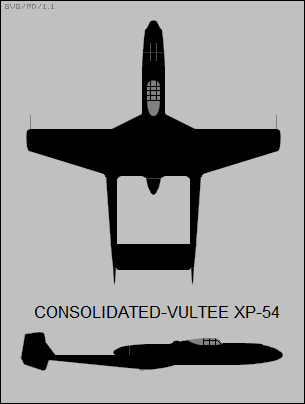
Planned armament was to consist of two 12.7-millimeter (0.50-caliber) Browning machine guns and two 37-millimeter cannon in the nose. The entire nose could be depressed three degrees or raised six degrees, a scheme that in hindsight sounds like it was likely to be more trouble than it was worth. The cockpit was armored and pressurized. Since the aircraft stood high above the ground, the pilot's seat was designed to be power-winched down below the fuselage to let the pilot get in and out. To bail out, the seat was to be catapulted out below the aircraft to clear the prop, making the XP-54 one of the first American aircraft with an ejection system. The belly entry and exit scheme meant the canopy could be fixed, making design of a pressurized cockpit simpler.
The XP-54 suffered from persistent weight increase as a consequence of the various changes in specification during its design phase, and it quickly became obvious that its performance was poor. However, the machine had a worse problem: the Lycoming H-2470 engine just could not be made to work right, and the engine development program was abandoned before the end of 1943. With no appropriate powerplant at hand, the XP-54 was effectively dead; the second prototype performed its first and only flight on 24 May 1944, but by that time the program was simply running on momentum. Both airframes ended up on the scrapheap.
* The Japanese Mansyu company worked on a heavy pusher ground-attack fighter, the "Ki-98", during the war, with a general configuration along the lines of that of the XP-54, but though work was performed on a prototype, the end of the war in the Pacific ensured that it never flew.
After the end of the war, the French Sud-Ouest company developed a twin-boom pusher carrier-based fighter, the "SO 8000 Narval", with two prototypes ordered by the Aeronavale, the French naval air arm, in 1946. The first prototype to fly performed its initial flight on 1 April 1949, with the other aircraft performing its first (and only) flight on 30 December. The Narval was interesting in appearance, reminiscent of the various unbuilt German "Luftwaffe 1946" designs, with a bubble-type canopy and wings with staggered sweep -- 24 degrees inboard, 13.5 degrees outboard. It was powered by an Arsenal 12 H-02 engine, a copy of a German Junkers Jumo 213 inline engine providing 1,680 kW (2,250 HP), driving contra-rotating propellers. It had tricycle landing gear, the nose gear retracting backward and the main gear retracting inward. It had a length of 11.83 meters (38 feet 10 inches), a span of 11.77 meters (38 feet 7 inches), and an empty weight of 4,821 kilograms (10,628 pounds).
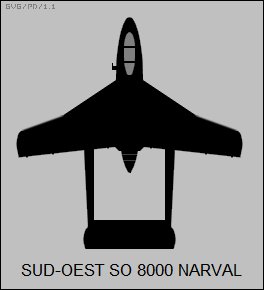
The two prototypes were unarmed, but the plan was to fit production machines with six 20-millimeter cannon. In service, the Narval would be able to carry an external load of 1,000 kilograms (2,200 pounds). It didn't get that far: development was troublesome, once in flight test the machine didn't come close to meeting its performance specifications, and the program was given the axe in early 1950. Proposals to fit the type with a Rolls-Royce Nene centrifugal-flow turbojet as the "SO 8010" went nowhere.
* That was the end of the twin-boom pusher fighter. However, in the 1960s the Cessna company of the USA introduced a twin-boom push-pull light utility aircraft, the "Skymaster", which proved to be arguably the most successful use of the configuration, with about 2,500 built in the US and France, serving ably both as a light civil aircraft and as a battlefield target spotter.
BACK_TO_TOP* Sources include:
Comments were also obtained from Urban Fredericsson's and Joe Baugher's websites.
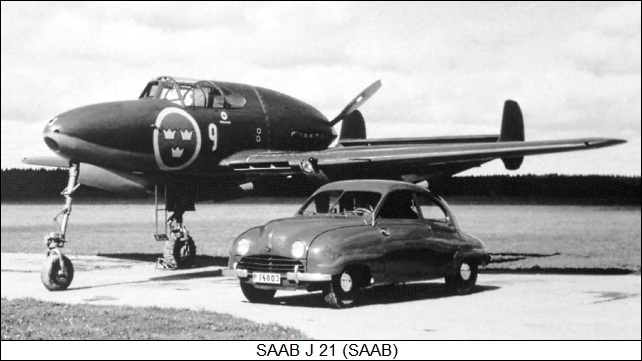
* Revision history:
v1.0.0 / 01 apr 07 v1.0.1 / 01 mar 09 / Review & polish. v1.0.2 / 01 feb 11 / Review & polish. v1.0.3 / 01 jan 13 / Review & polish. v1.0.4 / 01 dec 14 / Review & polish. v1.0.5 / 01 nov 16 / Review & polish. v1.0.6 / 01 oct 18 / Review & polish. v1.0.7 / 01 aug 20 / Review & polish. v1.0.8 / 01 jun 22 / Review & polish. v1.0.9 / 01 may 24 / Review & polish.BACK_TO_TOP
